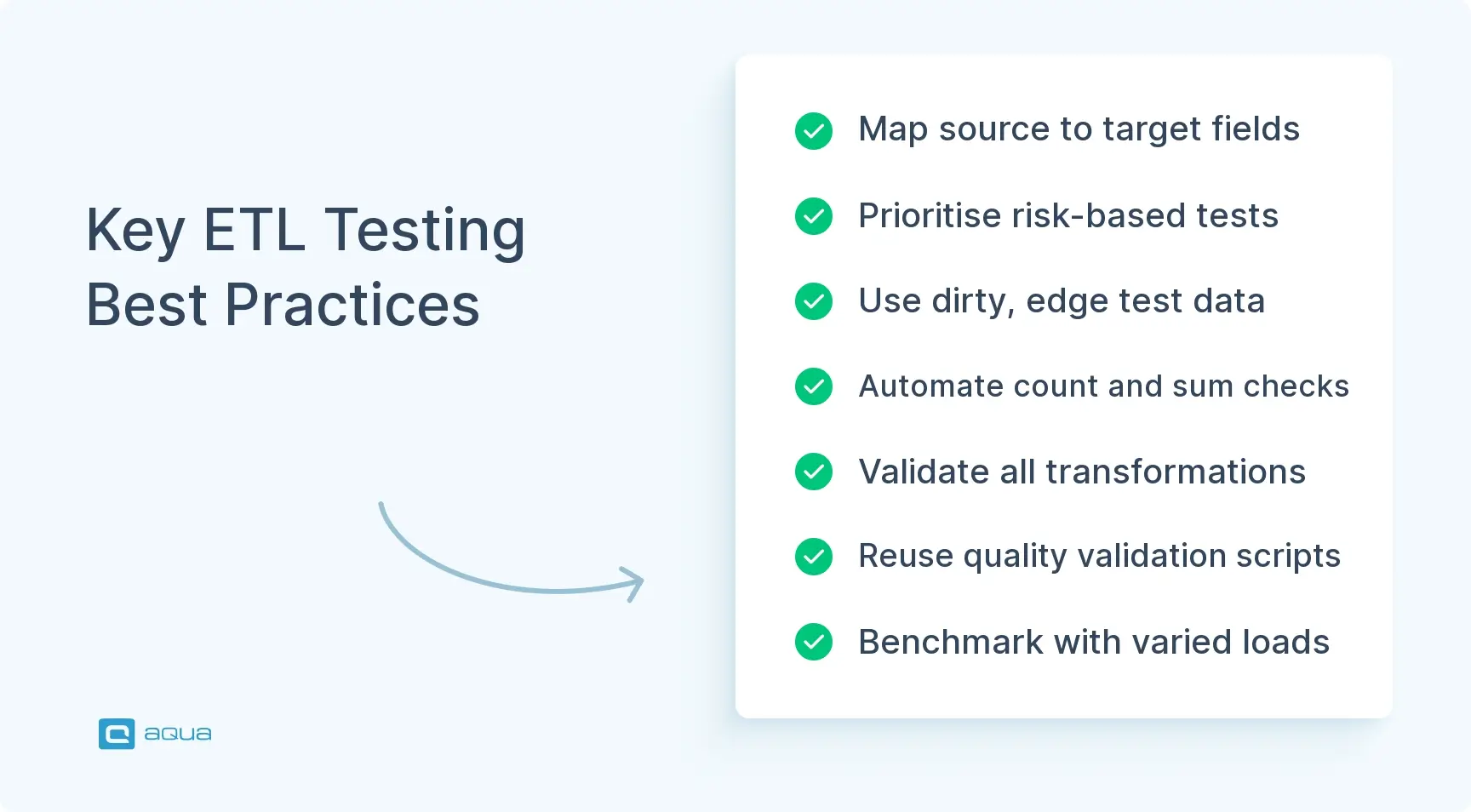Key Takeaways
- ETL testing validates data accuracy as information moves through Extract, Transform, Load processes to prevent corruption, transformation errors, and missing data in target systems.
- Effective ETL testing requires multiple testing types including data validation, transformation testing, data quality checks, and performance testing to catch different potential issues.
- ETL testers need a combination of SQL proficiency, data warehouse knowledge, business domain expertise, and analytical thinking to effectively validate data pipelines.
- The ETL testing process follows a systematic approach from understanding requirements to regression testing, with best practices including thorough data mapping documentation and testing with representative data.
- Modern ETL testing is evolving toward cloud-native testing, testing as code, AI-powered anomaly detection, and continuous validation approaches for real-time data pipelines.
When data moves between systems, hidden errors can lead to critical business decisions based on incorrect information. Discover how proper ETL testing prevents these costly mistakes 👇
What is ETL Testing?
ETL testing checks whether your data survives the journey from one system to another without getting disrupted. When information gets extracted from a source system, transformed to fit new requirements, and loaded into a destination like a data warehouse, problems can emerge at every step. ETL testing catches these issues before they reach production.
Here’s what happens without proper testing. Your company moves customer data from an old CRM to a new database. Customer phone numbers get scrambled. Purchase dates shift by a month. Entire records disappear. With ETL testing, you prevent these problems by validating each step of the process.
Why is it important? Because, for example, in healthcare companies, moving patient records between systems requires every medical history to stay accurate. One wrong medication dosage in the data could be dangerous. Retail companies combining online and store sales need consistent revenue calculations. Wrong numbers lead to bad business decisions.
Banks transfer transaction records between systems daily. Insurance companies consolidate claims data from multiple sources. Manufacturing firms combine production metrics from different plants. When business decisions depend on accurate data, ETL testing becomes essential. Bad data costs money and damages trust.
Types of ETL Testing
Your data goes through multiple stages and potential failure points, so you need different testing approaches to catch different types of problems. Some tests focus on whether data arrives intact, others check if transformations work correctly, and still others verify performance under load.
Data Validation Testing
Start with the foundation. This testing ensures data gets extracted correctly from source systems and validates that nothing goes missing during the process. You’re checking completeness and basic accuracy before anything else happens to your data.
Source to Target Count Testing and Source to Target Data Testing
Count your records first. If you extract 10,000 customer records, you should load 10,000 records unless your business rules specifically filter some out. Then dig deeper into the actual values. Customer John Smith in the source system should still be John Smith in the target, with the same email address and purchase history intact.
Data Transformation Testing
Your business rules need validation. If you’re converting currency amounts, standardising address formats, or calculating derived fields, test that these transformations produce the expected results. A misconfigured transformation rule can corrupt thousands of records at once.
Data Quality Testing
Look for the problems that slip through during processing. Duplicate records, missing phone numbers, inconsistent date formats, and invalid email addresses often surface during data movement. Catch these issues before they reach your target systems.
Performance Testing
Test how your ETL pipeline handles real-world conditions via performance testing. Can it process a full month of sales data within your maintenance window? How does it perform when multiple ETL jobs run simultaneously? Performance problems often only appear under actual load conditions.
Incremental ETL Testing
When running incremental loads, verify that only new or changed records get processed, not the entire dataset every time. Test scenarios where source data gets updated, deleted, or arrives out of sequence.
Regression Testing
Your ETL process evolves constantly. When you make changes to ETL code, run regression tests to ensure existing functionality still works correctly. A small change in one transformation can break downstream processes.
Metadata Testing and Integration Testing
Check that column definitions, data types, and schema information remain consistent across systems. Test how your ETL process works with downstream reporting systems and upstream data sources. ETL processes rarely work in isolation.
Each testing type catches different potential issues. Combine them strategically based on your specific data pipeline risks and business requirements.
When and Why to Conduct ETL Testing
ETL testing becomes critical at specific moments in your data pipeline lifecycle. Understanding these triggers helps you plan testing efforts and avoid data disasters when they matter most.
When Your Data Pipeline Needs Testing
During Major System Changes: Test when migrating from your old CRM to Salesforce, or when upgrading from SQL Server 2016 to 2022. System changes often break data mappings and field compatibility in unexpected ways.
Before Adding New Data Sources: Your marketing team wants to integrate HubSpot data with existing customer records. Test the integration thoroughly before connecting new systems to avoid corrupting your existing clean data.
After Business Logic Updates: Sales commission calculations changed from 5% to a tiered structure. Customer segmentation rules now include geographic factors. Any time business requirements change, your ETL transformations need validation.
During Regular Health Checks: Set up monthly validation tests for critical data flows. Weekly checks for high-volume processes like transaction imports. Daily monitoring for real-time data feeds that feed customer-facing applications.
Why ETL Testing Prevents Business Problems
Avoiding Expensive Mistakes: Wrong inventory data leads to stockouts or overordering. Incorrect customer segmentation wastes marketing budget on the wrong audiences. Bad financial data causes regulatory reporting errors that trigger audits and fines.
Maintaining Decision Quality: Executive dashboards showing last quarter’s data as current numbers lead to poor strategic decisions. Sales forecasts based on incomplete pipeline data result in missed targets and resource misallocation.
Building Team Confidence: Data analysts stop questioning every report when they trust the underlying data. Business users rely on self-service analytics instead of creating manual spreadsheets. IT teams spend less time troubleshooting data issues and more time on strategic projects.
ETL testing protects your organisation’s decision-making capability. Plan it as part of your data strategy, not an afterthought when problems emerge.
Key Features of ETL Testing
Now that you understand when to test, let’s look at what your ETL testing actually needs to accomplish. These core testing activities form the foundation of any reliable data pipeline validation strategy.
- Data Accuracy Verification: Confirms data values correctly reflect source information after all transformations
- Transformation Logic Validation: Ensures business rules are properly applied during the transform phase
- Data Completeness Checks: Verifies all expected records and fields are present in the target system
- Referential Integrity Testing: Validates that relationships between data elements remain intact
- Error Handling Validation: Tests how the ETL process manages exceptions and invalid data
- Performance Benchmarking: Measures throughput, processing time, and resource utilization
- Incremental Load Testing: Confirms delta/incremental updates work correctly without duplicating data
- Data Type Validation: Ensures data formats and types are maintained or properly converted
- NULL Handling Verification: Tests that NULL values are processed according to specifications
- Boundary Condition Testing: Validates that extreme values are handled correctly
These testing activities require specific skills and knowledge that traditional software testers might not have. Successfully implementing ETL testing depends on having the right team members with the right expertise.

Roles and Skills of ETL Testers
ETL testing requires a unique blend of technical database expertise and business understanding. These professionals bridge the gap between raw data and reliable business intelligence, catching problems that could derail important decisions.
As you work through the complexities of ETL testing, having the right tools can make all the difference in maintaining data quality throughout your pipeline. This is where aqua cloud’s test management capabilities shine.
With aqua’s AI-powered test case generation, you can automatically create comprehensive test scenarios for your ETL processes in seconds, from data extraction validation to complex transformation rules. The platform allows you to centralise both manual and automated testing efforts, giving you complete traceability from requirements to execution. For data-intensive testing, aqua streamlines test data management by generating test datasets directly from uploaded files, ensuring your ETL tests cover all critical scenarios. Plus, with seamless integrations to tools like Jira, Azure DevOps, and Confluence, you maintain clear documentation of complex data mappings and transformations throughout your testing lifecycle.
Reduce ETL testing time by 40% while achieving complete data pipeline coverage
What ETL Testers Actually Do
ETL testers spend their days diving deep into data flows and transformations. They’re the detectives who ensure your customer data survives the journey from legacy systems to modern warehouses without getting corrupted along the way.
- Analyse data mapping requirements: to understand how information should transform between systems
- Create comprehensive test cases: covering every transformation scenario, from simple field mappings to complex calculations
- Execute validation tests: comparing source and target data to catch discrepancies and corruption
- Document issues and track resolution: working with ETL developers to fix transformation problems
- Automate repetitive testing tasks: and run regression tests when ETL code changes
- Validate performance requirements: ensuring ETL processes handle real-world data volumes within time constraints
- Monitor data security and compliance: making sure sensitive information stays protected during transfers
Skills That Make ETL Testers Effective
The best ETL testers combine technical precision with business curiosity. They understand both how data should transform and why it matters to the organisation, making them essential guardians of data quality.
- SQL proficiency: for writing complex queries to validate transformations and identify anomalies
- Data warehouse knowledge: understanding database concepts, schemas, and ETL tool functionality
- Business domain expertise: knowing how customer data, financial transactions, or inventory actually work
- Analytical thinking: to spot patterns in data discrepancies and trace problems to root causes
- Attention to detail: when comparing large datasets and catching subtle transformation errors
- Scripting abilities: using Python, PowerShell, or shell scripts to automate validation tasks
- Communication skills: explaining complex technical issues to business stakeholders
- Problem-solving mindset: troubleshooting data issues that span multiple systems and processes
This dual technical and business perspective makes ETL testers critical for maintaining data integrity in organisations that depend on accurate information for decision-making.
The ETL Testing Process: Steps and Best Practices
Testing your ETL process isn’t something you can wing. You need a systematic approach that catches problems before they corrupt your production data. Here’s how to build confidence in your data pipeline from start to finish.
Step 1: Understand Requirements and Data Mapping
Start with the basics. What’s supposed to happen to your data? Thoroughly review business requirements, source-to-target mappings, and transformation rules before writing a single test case. You can’t test what you don’t understand.
Best Practice: Create data mapping documents that clearly show the journey of each data element from source to destination.
Step 2: Identify Test Scenarios
Now comes the planning phase. Which parts of your ETL process are most likely to break? Determine what needs testing by focusing on extraction accuracy, transformation rules, and loading procedures that matter most to your business.
Best Practice: Categorise test scenarios by risk level to prioritise critical data elements that impact business decisions.
Step 3: Prepare Test Data
You might ask, “What kind of data should I test with?” Don’t just use clean, perfect data. Create representative test sets that include the messy reality your ETL process will face in production.
Best Practice: Include boundary values, NULL values, and special characters in your test data to thoroughly test transformation logic.
Step 4: Design Test Cases
Time to get specific. Develop detailed test cases that spell out exactly what should happen in each scenario. Vague test cases lead to missed bugs and confused team members.
Best Practice: Use a consistent template for test cases that includes preconditions, steps, expected results, and actual results.
Step 5: Execute Source to Target Testing
Compare data in your source and target systems to verify that extraction and loading actually work as designed. Did everything make it through intact?
Best Practice: Automate count and sum checks to quickly identify discrepancies between source and target.
Step 6: Validate Data Transformations
Just because data arrived doesn’t mean it transformed correctly. Verify that business rules and transformations have been applied properly to your data.
Best Practice: Create SQL queries that can independently validate transformation logic against source data.
Step 7: Perform Data Quality Checks
What about the data quality itself? Test for duplicates, missing values, and inconsistencies that could pollute your target systems. Clean data going in doesn’t guarantee clean data coming out.
Best Practice: Develop reusable data quality validation scripts that can be run against any new data load.
Step 8: Test ETL Performance
Okay, so your data is accurate and complete. But can your ETL process handle real-world volumes? Evaluate the time and resources required for completion under actual load conditions.
Best Practice: Benchmark performance with various data volumes to identify potential scaling issues before they impact production.
Step 9: Document Results and Report Defects
Found problems? Record your test results and report issues with enough detail that developers can actually fix them. Vague bug reports waste everyone’s time.
Best Practice: Include detailed reproduction steps and data examples when reporting defects to speed up resolution.
Step 10: Regression Testing After Fixes
Re-test after defects get addressed to ensure fixes don’t break something else. It happens more often than you’d think.
Best Practice: Maintain a core set of regression tests that can quickly verify the entire ETL process remains functional.
Remember, effective communication between testers, developers, and business stakeholders makes this entire process work. Skip the dialogue, and you’ll spend more time fixing problems than preventing them.
Challenges in ETL Testing
ETL testing sounds straightforward until you actually try to do it. Then reality hits, and you discover that testing data pipelines brings unique challenges that traditional software testing never prepared you for. Let’s tackle the biggest obstacles and how to overcome them.
Common Challenges and Solutions
Massive Data Volumes: Ever tried to test a complete customer database with 50 million records? Your test environment crashes, queries take hours to run, and you’re still waiting for results when the deadline passes.
Solution: Use sampling techniques and focus on high-risk data segments. Test with representative subsets that include your edge cases without grinding your systems to a halt. Implement incremental testing approaches that validate data changes rather than entire datasets.
Complex Transformation Logic: Business rules can get incredibly complex. You’re validating calculations that span multiple tables, apply different logic based on customer types, and include exceptions for legacy data formats. Where do you even start?
Solution: Break down complex transformations into smaller, testable units. Create independent verification queries that can validate each piece of the logic separately. Think of it like unit testing for your data transformations.
Lack of Complete Source Documentation: What does the field “CUST_STATUS_CD” actually mean? Is “Y” active or inactive? Source systems often come with minimal documentation, leaving you to guess what the data represents.
Solution: Work with business users to develop data dictionaries that explain what fields actually mean. Conduct source system profiling to understand data patterns and relationships. Sometimes the data tells its own story if you know how to look.
Time Constraints: “We need to go live next week, can you just quickly test the ETL?” – sound familiar? ETL testing often faces compressed schedules that don’t account for the complexity involved.
Solution: Automate repetitive validation tasks wherever possible. Prioritise testing critical data elements that directly impact business decisions. Focus your manual testing efforts on the high-risk areas that automation tools can’t handle effectively.
Environment Availability: Your test environment has last year’s data structure, half the source systems are unavailable, and it crashes every Tuesday. How are you supposed to test realistic scenarios?
Solution: Create virtualised test environments when possible. Develop portable test scripts that work across different environments with minimal configuration changes. Build flexibility into your testing approach from the start.
Data Privacy Concerns: Using production data for testing sounds logical until legal and compliance teams get involved. Customer PII, financial records, and healthcare data can’t just be copied to test systems.
Solution: Implement data masking techniques that preserve data relationships while protecting sensitive information. Use synthetic test data generation that mimics production patterns without exposing real customer data.
Changing Requirements: Just when you finish testing the customer segmentation logic, the business team decides to change the rules. Again. Requirements volatility can make your test cases obsolete overnight.
Solution: Maintain version-controlled test cases that can adapt to requirement changes. Implement automated regression testing that can quickly validate whether changes break existing functionality.
Tool Limitations: Your ETL testing tool works great with SQL Server, but chokes on JSON data from the new API. No single tool handles every data format, volume, or complexity you’ll encounter.
Solution: Combine multiple tools and custom scripts to create comprehensive test coverage. Build a testing toolkit rather than relying on a single solution. Sometimes the best approach involves mixing commercial tools with homegrown scripts.
The most successful ETL testing teams don’t try to solve every challenge with the same approach. They stay flexible, automate what they can, and focus their human expertise where it matters most. Expect these challenges, plan for them, and you’ll avoid the painful surprises that derail ETL projects.
Recommended ETL Testing Tools
So you’ve identified the challenges and you’re ready to tackle ETL testing seriously. But which tools should you actually use? The answer depends on your specific situation, but here are the options that real teams rely on for their data pipeline testing.
| Tool Name | Type | Key Features | Best For |
|---|---|---|---|
| QuerySurge | Commercial | Data warehouse-specific testing, automated comparison, visual reports | Enterprise ETL testing with large data volumes |
| Informatica Data Validation | Commercial | Built-in transformation validation, metadata testing, data profiling | Organisations already using Informatica ETL |
| Datagaps ETL Validator | Commercial | Visual mapping verification, automated regression, and scheduling | Mid-to-large organisations needing comprehensive testing |
| SQL Developer | Free/Oracle | Data comparison, SQL execution, explain plans | Oracle-based ETL testing with manual approach |
| DBUnit | Open Source | Dataset comparison, database state management, JUnit integration | Java developers performing ETL testing |
| Apache NiFi Test | Open Source | Flow testing, processor validation, and content verification | Testing NiFi-based ETL workflows |
| Talend Open Studio | Open/Commercial | Built-in testing components, data quality assessment | Organisations using Talend for ETL processes |
| Datamaker | Commercial | Test data generation, subsetting, masking | Creating synthetic test data for ETL testing |
| Snowflake’s Query Profile | Built-in | Query performance analysis, execution visualisation | Testing ETL processes in Snowflake environments |
| Python (with Pandas/Great Expectations) | Open Source | Flexible scripting, custom validations, integration options | Custom ETL testing solutions with specific requirements |
Don’t expect to find a perfect all-in-one solution. Most successful teams combine specialised tools with custom SQL scripts to get comprehensive coverage. Consider your existing tech stack, team skills, and budget when making decisions. The best tool is the one your team will actually use consistently. Once you’ve got your tools sorted, you’ll need to define exactly what you’re going to test and how deep to go with your validation efforts.
Now that you understand the critical importance of robust ETL testing for maintaining data integrity, the next step is implementing a systematic approach that scales with your growing data needs. aqua cloud delivers exactly what data testing teams need: a unified platform where you can generate ETL test cases using AI, manage test data efficiently, and integrate with your existing data pipeline tools. The platform’s intelligent test prioritisation ensures you focus on the most critical data validations first, while comprehensive audit logging captures every test execution for compliance and governance requirements. With aqua, you’ll experience up to 97% time savings in test case creation and management, allowing your team to focus on complex data validation rather than administrative tasks. The platform’s rich dashboards and reporting capabilities provide immediate visibility into test coverage and data quality issues, helping you catch potential problems before they impact business decisions. Ready to transform how your organisation approaches ETL testing?
Achieve 100% data integrity with 97% less effort using AI-powered test management
Scope of ETL Testing
You’ve got your tools and understand the challenges. So what exactly needs testing in your ETL pipeline? Think of scope as your testing boundaries: what’s in, what’s out, and how deep you go.
Your testing scope should cover the entire data journey:
- Source data validation to establish your baseline before extraction begins
- Extraction testing to ensure you’re getting the right data from source systems
- Transformation validation where most problems hide in business rules and calculations
- Loading verification to confirm data arrives correctly in target systems
- End-to-end integration to make sure the whole pipeline works together
- Performance testing under realistic data volumes and processing conditions
- Error handling validation for when things inevitably go wrong
- Security and metadata testing for compliance and audit trail requirements
You don’t test everything equally. Critical customer data gets intensive testing. Reference tables that rarely change? Light validation might suffice. Tailor your scope based on business risk and data importance.
The goal isn’t perfect coverage of every possible scenario. It’s comprehensive coverage of the scenarios that matter most to your business. Focus your testing energy where data problems would cause the biggest headaches, and you’ll build a scope that actually protects what matters.
Future Trends in ETL Testing
ETL testing isn’t standing still while data technology races ahead. New approaches are emerging that will change how you validate data pipelines in the coming years. Here’s what’s gaining momentum and why it matters for your testing strategy.
Cloud-Native Testing Gets Serious: Your ETL workloads are moving to the cloud, and your testing needs to follow. Teams are adopting container-based testing, serverless validation functions, and cloud-specific performance tools. Testing in distributed environments requires different approaches than traditional on-premise validation.
Testing as Code Becomes Standard: Remember when infrastructure as code seemed like overkill? Testing as code is following the same path. Organisations are defining test cases in version-controlled repositories using declarative languages. This creates more repeatable, auditable testing processes that can evolve alongside your data pipelines.
AI Starts Spotting Data Problems: Machine learning algorithms are getting better at identifying data anomalies that rule-based testing misses. These tools learn normal data patterns and automatically flag unusual deviations. It’s like having a smart assistant that notices when customer behaviour data suddenly looks weird.
Continuous Testing Matches Real-Time Data: Batch processing testing isn’t enough anymore. The shift toward real-time data pipelines demands continuous testing approaches that validate data quality at multiple points throughout the data lifecycle, not just during scheduled batch runs.
DataOps Brings Teams Together: ETL testing is integrating more tightly with DataOps practices. This means better collaboration between data engineers, testers, and analysts throughout pipeline development, instead of testing happening in isolation at the end.
Business Users Join the Testing Party: Self-service testing tools are enabling non-technical users to validate data transformations without writing complex SQL queries. Marketing analysts can now test their own customer segmentation rules without waiting for technical teams.
Adapt to these trends, and you will maintain higher data quality while handling increasingly complex and real-time data environments. The future belongs to teams that can test as fast as they can build.
Conclusion
ETL testing keeps your business data trustworthy when it matters most. You know those monthly revenue reports that executives use to make budget decisions? The customer segmentation that drives your marketing campaigns? The inventory levels that determine what to order next? All of that depends on data moving correctly through your ETL pipelines without getting corrupted along the way. Start with basic source to target validation, automate what you can, and focus your energy on testing the data transformations that directly impact business decisions. The effort you put into solid ETL testing now prevents those painful moments when someone discovers the quarterly numbers are wrong because a data conversion failed three months ago. Nobody celebrates good ETL testing, but everyone notices when it’s missing.


















